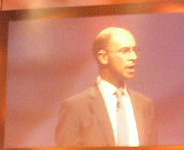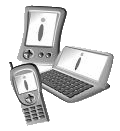
Summary of the
Symbian Exposium 2003
April 29 - 30, London UK
Differentiation without Fragmentation
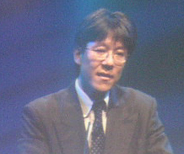
Expand the Sony group into the
mobile world

Micro segmentation known from car
industry will dominate market
growth in the mobile arena
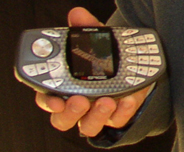
Click to see a picture of the man
who is responsible for
N-Gage partnering
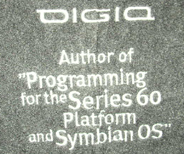
See the guy who apologized for
all the mistakes made in the
first book on Series 60

London Docklands
Click to get more pictures from the exhibition

Expand the Sony group into the
mobile world

Micro segmentation known from car
industry will dominate market
growth in the mobile arena

Click to see a picture of the man
who is responsible for
N-Gage partnering

See the guy who apologized for
all the mistakes made in the
first book on Series 60

London Docklands
Click to get more pictures from the exhibition
It began
with an inspiring opening: a light show complemented by a cinematic video
sequence that probably burnt Symbian's and its partners brand names in
every segment of the visitors memory.
Like in the last year the keynote speeches gave a good prospect of what is happening in the mobile world and what philosphies drive the economic decisions of the big players.
David Levin, CEO of Symbian, made the first speech. He is a guy who speakes without notes in a very professional way. Every sentence of his talk completed a picture of Symbian's vision of the market and the challenges Symbian related companies have to face.
After him Rikko Sakaguchi, Senior VP of SonyEricsson and former strategist for consumer electronics at Sony, gave a very good introduction into the SonyEricsson view of the Symbian world telling what people really expect from a mobile phone and listing the requirements the mobile industry has to fulfill to get a maximum of market opportunities.
Then it came to Ed Candy. While Rikko made 2 pictures for his mother in Japan probably only to show his P800 to the audience, Ed claimed that his mother sitting in Australia loves to see him on video and placed a camera phone in front of him waving his hand to greet a supposed person. His presentation was a Forrester Research kind of speech, summarizing that his mobile masterplan envisioned in 1987 became true, fully corresponding to the reality we have now. But some of his slides that I will add later where quite interesting as he is member of the UMTS Task force of the mobile industry.
As the last speaker, Peter Zapf, President of Mobile Phones within the ICM group at Siemens, gave a much more realistic overview of the lessons learned at Siemens and the outlook he and his people are depicting.
Similar to the last year the keynotes of day 2 were substantially more marketing oriented and the bottom line of the speeches were not so far reaching.
I tried to summarize the statements, conclusions and prospects heard at the Expo in a new way, merging all the pieces into an easy to read list. This includes keynotes and workshops of both days.
Like in the last year the keynote speeches gave a good prospect of what is happening in the mobile world and what philosphies drive the economic decisions of the big players.
David Levin, CEO of Symbian, made the first speech. He is a guy who speakes without notes in a very professional way. Every sentence of his talk completed a picture of Symbian's vision of the market and the challenges Symbian related companies have to face.
After him Rikko Sakaguchi, Senior VP of SonyEricsson and former strategist for consumer electronics at Sony, gave a very good introduction into the SonyEricsson view of the Symbian world telling what people really expect from a mobile phone and listing the requirements the mobile industry has to fulfill to get a maximum of market opportunities.
Then it came to Ed Candy. While Rikko made 2 pictures for his mother in Japan probably only to show his P800 to the audience, Ed claimed that his mother sitting in Australia loves to see him on video and placed a camera phone in front of him waving his hand to greet a supposed person. His presentation was a Forrester Research kind of speech, summarizing that his mobile masterplan envisioned in 1987 became true, fully corresponding to the reality we have now. But some of his slides that I will add later where quite interesting as he is member of the UMTS Task force of the mobile industry.
As the last speaker, Peter Zapf, President of Mobile Phones within the ICM group at Siemens, gave a much more realistic overview of the lessons learned at Siemens and the outlook he and his people are depicting.
Similar to the last year the keynotes of day 2 were substantially more marketing oriented and the bottom line of the speeches were not so far reaching.
I tried to summarize the statements, conclusions and prospects heard at the Expo in a new way, merging all the pieces into an easy to read list. This includes keynotes and workshops of both days.
| List of statements |
Who said it ? |
| 1. The Symbian Smartphone
market is growing. |
David Levin |
| 2001 = about 0.5 million
Symbian OS products shipped |
David Levin |
| 2002 = more than 2.1
million Symbian products shipped |
David Levin |
| 2003 = already 1.18
million Symbian products shipped in Q1/2003 |
David Wood |
| 2004 = about 60 million SmartPhones
in the market |
Peter Zapf |
| 2005 = about 110 million SmartPhones
around globally |
Peter Zapf |
| 2. There are new products
and there will come a lot of new things |
David Levin |
| Symbian announced the latest
Symbian release: version 7.0s |
David Levin |
| 21 products in development
with 10 Symbian licensees (17 new things + the SX-1 from Siemens, the
D700 from Samsung, N-Gage from Nokia and the P30 from BenQ). |
David Levin |
| Another 19 future projects
being discussed with 9 licensees (how many of these ongoing discussions
will be successful is unknown yet) |
David Levin |
| Sendo is announcing a phone
based on Symbian OS 6.1 and Series 60 1.2 for X-mas 2003. |
Sander van der Meer |
| 3. What will drive the
business? |
Rikko Sakaguchi |
| Applications and Content are
the most important thing for SonyEricsson today. |
Rikko Sakaguchi |
| Living and contributing to the Symbian ecosystem: SonyEricsson will make the developer program as comprehensive as possible through competitions, events, mailings and more. | Rikko Sakaguchi |
| SonyEricsson created an application
market place in cooperation with handango.com. A collaboration
with IBM will help to connect users to their backoffice. |
Rikko Sakaguchi |
| The SonyEricsson's strategy
intends to expand the product line based on Symbian OS through: applications
(imaging, messaging with a strong believe in Instant Messaging, because "to
feel connected" is the killer app), entertainment (games, animations, music,
video) and business solutions. A further objective is to extend the Sony
Group into the mobile world. |
Rikko Sakaguchi |
| The Sony Group strategic vision:
there are now 4 gateways into the 'Sony ubiquitous "value" Network': Vaio
PC, WEGA TV, Play Station and the SonyEricsson P800. |
Rikko Sakaguchi |
| Value chain share at Siemens
is moving from 70% hardware and 30% software to 70% software and 30% hardware. |
Peter Zapf |
| Like in the car industry a
kind of platformization will take place: standardization of components
and a business segmentation will let handset manufacturers transform themselves
from hardware manufacturers to software and application providers. Network
operators are enabled to get custom-made mobile phones with the right applications
for their target group. |
Peter Zapf |
| Sendo looks for Killer
Apps. Example: a soap story delivered in single MMS messages. V.d. Meer
reminds the developer: Keep in mind the balance between an application for
the network operator, who wants to make money with data traffic and the comsumer,
who wants to save money by playing games offline. |
Sander van der Meer |
| Symbian's view: PDA sales
are dropping and laptops are not well suited as mobile companions. So mobile
phones will surpass wireless PDA's. For Symbian there are 3 stages of engagement
and interest: Simply better phones, the platform Symbian OS and the ecosystem
consisting of licensees and partners. This gives a rich range of
solutions for manufacturers and network operators. |
David Wood |
| Leave nothing to chance: simplicity
has to be engineered into the device. Example of user interface design
differences: users with Motorola handset send 14 sms per
month, Nokia device users 45 sms. This is a difference of about 4 Euro/customer
! |
Nick Balderson, Orange |
| There is a symbiotic relationship
between platform owners and developers. Underlining the high importance
of gaming (after a study made by orange and in-fusio on mobile gaming):
read results
here. Console case study: 4 million PS/2 sold 2002 in U.S. together
with 45 million units for PS/2 titles. |
Jim Welch, Metrowerks |
| Evolution: A PC from 1994
had the processing power of a phone today. A 1998 PC has the processing power
of a phone next year. A phone in 2004 will have the processing power of
a SEGA Dreamcast. |
Jim Welch, Metrowerks |
| 4. Conclusions and Observations |
|
| Java: as there are
hardware accelerators available (bytecode execution directly in hardware)
and APIs for nearly every task, why not build a mobile phone OS completely
in Java? Handset manufacturers would save the cost for Symbian OS and the
Series 60 license... |
Matthew Whitcombe (www.renesas.com) |
| Interesting that even manufacturers
of hardware and media are now developing applications and software
for mobile phones. Bluetooth software is still in its early beginnings.
|
A guy from TDK who was investigating
the progress of bluetooth (on device driver level). |
| Simple to use but powerful
suites of tools become available in an increasing number: OPL, Visual
Basic (AppForge), Java (with performance profiling, network + memory monitoring
tools and obfuscation support), RenderWare Studio and some more. Even the
C++ community can now decide between Visual C++ and SDK, Borland C++ Builder
MobileSet and Metrowerks CodeWarrior. |
Nils Reimelt |
| Sendo seems to do a
good job in migrating from Microsoft based software to Symbian. Representatives
say < 2% of the developers have left after switch to Series 60. |
Nils Reimelt |
| Sendo has probably the best
developer initiative around, taking a real "hands-on" approach after
benchmarking all other developer support sites. I spoke to a senior software
engineer who told me that the switch to Symbian OS was very hard at the
beginning for Sendo's system architects but is now becoming easier. All
the learnings are flowing into the developer site at www.sendo.com for
the benefit of a rising developer community. |
Nils Reimelt |
| There is a new book available
(with CD-Rom): Symbian OS C++ for Mobile Phones. Symbian has learnt
a lot from the 3 years old book Professional Symbian Programming,
so the new one is much better and more complete. |
David Wood |
| 5. Overall Impressions |
|
| The community of Symbian C++
developers is still split into two groups: those with the Symbian OS source
code, who have access to the answers of all questions and those without,
who have a steep and hard learning curve. But the feature list of Symbian
OS v7.0s seems to have the solution for a number of problems known to the
C++ developer. |
Nils Reimelt |
| Exhibiting companies told that
they hoped to see more business and marketing people. Perhaps the Symbian
expo will transform into a more business oriented event in the course of
time but at present it is a developer event and attendants come from the
hard- and software industry. |
Nils Reimelt |
| Like in the last year the
conference was well organized. Material (handouts) was provided as one book
the size of the yellow pages for each day. A CD-Rom would probably have been
better, but progress was made compared to last year. |
Nils Reimelt |
| The exhibition hall was about
the same size as last year but there were a couple of new booths. So the
hall was stronger packed giving space to more companies and theme-based
stands (games arcade, enterprise pavilion, Series 60 area), There were
noticeable more participants than in the last year. |
Nils Reimelt |
| 6. Mantras |
|
| Go as far as you can see,
and when you get there, you see further. |
Lightshow |
| Innovation through differentiation. |
David Levin |
| Differentiation without fragmentation. |
David Levin |
| An open platform is fundamental,
open standards are friends of competition and innovation. |
Rikko Sakaguchi, David Levin |
| Openness fuels market growth
and innovation! |
Peter Zapf |
Director Technology, Burda Wireless
